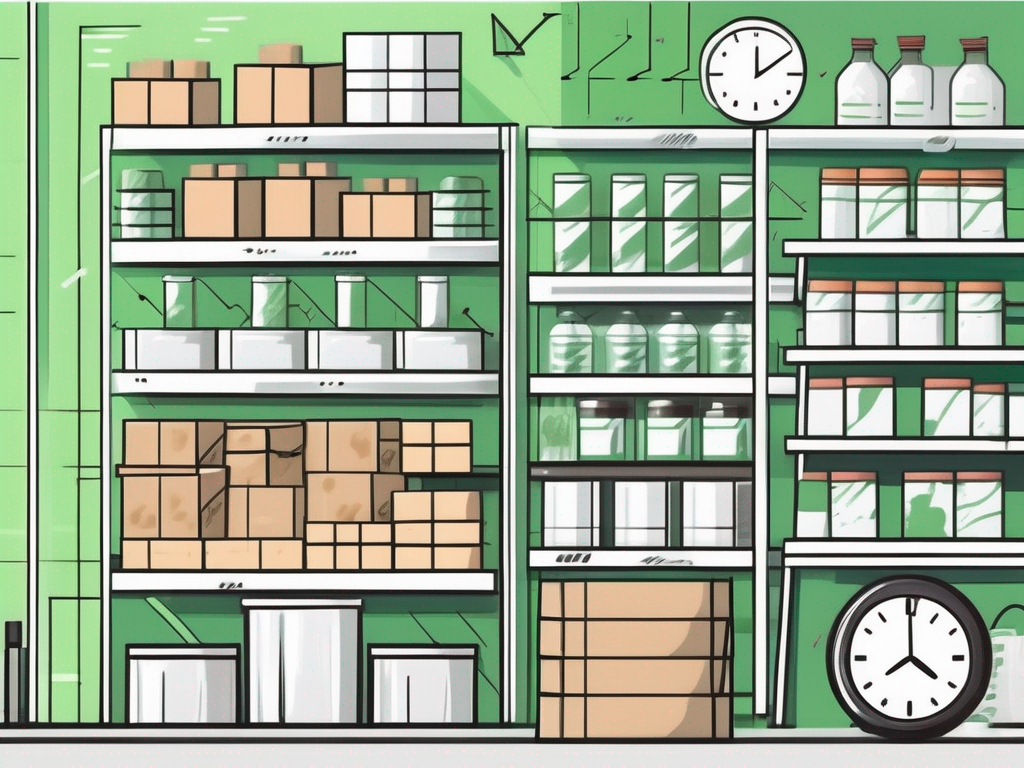Share this
Your Guide on How to Create an Inventory Strategy
by Christie McLeod on Jul. 21, 2022

Part One
Choosing the right partner can make or break your company’s logistics, customer service, and repeat purchases. Using a fulfillment center like Shipfusion frees you from navigating the fulfillment landscape with zero stress. Below are some insights on how Shipfusion can take your business to the next level.
What is Inventory Strategy?
Inventory management is a strategic process that determines the right stock level to maintain to meet customers’ needs. The main goal of inventory management is to minimize the cost of inventory while maximizing customer satisfaction. Businesses adopt various inventory strategies, depending on the type of products they sell and their business model. Some common inventory strategies include make-to-order, make-to-stock, and just-in-time.
Make-to-order is a manufacturing strategy where products are only made once a customer order has been placed. This type of inventory strategy is often used for customized products or products with a long lead time.
Make-to-stock is a manufacturing strategy where products are made in advance and stored in inventory until a customer order is placed. This type of inventory strategy is often used for products with a shorter lead time.
Just-in-time is an inventory strategy where inventory is only replenished once it has been sold. This type of inventory strategy is often used in manufacturing and is intended to minimize waste and inventory overhead costs.
Inventory Management Solutions You Can Apply Right Now
A sound inventory management system allows businesses to track and control their stock of products. It is a vital part of any business that sells physical goods, as it ensures that the right products are in stock at the right time to meet customer demand.
Many different types of inventory management solutions are available to businesses, each with its own advantages and disadvantages. Some of the most popular solutions include:
Inventory Forecasting
Inventory forecasting can have a significant impact on inventory management. By forecasting future inventory needs, businesses can avoid the costly mistake of over-ordering or under-ordering inventory.
An accurate inventory forecast can help businesses save money in a number of ways:
- It can help businesses avoid the cost of carrying excess inventory.
- It can help businesses avoid the cost of lost sales due to stock-outs.
- It can help businesses avoid the cost of expedited shipping charges to meet customer demand.
Inventory forecasting is not an exact science, and there are a number of factors that can impact the accuracy of a forecast. Nevertheless, businesses that take the time to develop a sound forecasting system can reap significant benefits in terms of cost savings and improved customer satisfaction.
Advantages: There are many advantages and disadvantages to inventory forecasting. The main advantages are that forecasting can help to avoid stock-outs, identify potential problems early, and allow businesses to plan for future demand.
Another advantage of forecasting is that it can help businesses to identify potential problems early. If a business knows that it is going to have a high level of demand for a product, it can plan ahead and make sure that it has enough inventory to meet that demand. If a business does not forecast demand, it may not be able to meet customer demand and could lose sales.
Disadvantages: The main disadvantage is that forecasting can be inaccurate. This is because it can be difficult to predict future demand accurately. Businesses can use various methods to try to improve the accuracy of their forecasts, but there is always some element of uncertainty.
Another disadvantage of forecasting is that it can be costly and time-consuming. Businesses need to invest in resources such as software, data, and staff time in order to generate forecasts. In addition, companies need to update their forecasts as demand can change over time regularly.
Barcode Management
Barcode inventory management solutions make use of barcodes to track stock levels and movements. Barcodes are attached to product SKUs and then scanned whenever they are added to or removed from inventory. This information is then stored in a central database, allowing businesses to see immediately what products are in stock and where they are located.
This information can be used to order products when stock levels are low and to avoid overordering. Barcoding can also help businesses to keep track of where their products are located. This is particularly useful in warehouses, where products may be stored in different locations. By scanning the barcodes of products, businesses can quickly and easily find the products they need.
Advantages: Barcode inventory management solutions are relatively simple and easy to use. They also offer a high degree of accuracy, as barcodes can be scanned quickly and easily.
Disadvantages: Barcode inventory management solutions can be expensive to set up, as businesses need to purchase barcode scanners and labels. They can also be time-consuming, as each product needs to be individually labeled.
Overall, barcoding is a helpful technology that can make inventory management more efficient. By tracking products with barcodes, businesses can save time and money.
Radio Frequency Identification (RFID)
RFID inventory management solutions make use of radio frequency tags to track stock levels and movements. RFID tags are attached to products and then scanned whenever they are added to or removed from inventory. This information is then stored in a central database, allowing businesses to see at a glance what products are in stock and where they are located.
Advantages: RFID inventory management solutions offer a high degree of accuracy and can track large numbers of products quickly and easily. They also do not require each product to be individually labeled.
Disadvantages: RFID inventory management solutions can be expensive to set up, as businesses need to purchase RFID scanners and tags. They can also be difficult to implement, as RFID tags need to be carefully placed on products.
The inventory management process was often manual and paper-based, which was prone to errors. With the advent of radio frequency identification (RFID), inventory management can now be automated and made more accurate. This information can then be used to track inventory levels and orders.
RFID can be used to track inventory in a number of ways. For example, when a product is received at a warehouse, the RFID tag can be read and the information transmitted to the computer. This can trigger an update to the inventory management system so that it knows the product has been received. Similarly, when a product is shipped out, the RFID tag can be read and the information transmitted to the computer, which can then update the inventory management system accordingly.
Overall, RFID can be a valuable tool for inventory management. Automating the process of tracking inventory, can help to reduce errors and improve efficiency.
Cycle Counting
Cycle counting is a method of inventory management that involves counting a small selection of products on a regular basis. This information is then used to estimate the stock levels of all products.
Advantages: Cycle counting is a relatively simple and easy-to-use inventory management solution. It is also less time-consuming than other solutions, as businesses only need to count a small selection of products.
Disadvantages: Cycle counting can be inaccurate, as it is based on estimates rather than actual stock levels. It can also be disruptive to business operations, as it requires employees to stop what they are doing to count products at a particular time during the day or week.
Inventory management is critical for businesses in order to maintain control of their stock, ensure they are meeting customer demands, and avoid overspending. One key element of effective inventory management is cycle counting.
Cycle counting also allows businesses to keep a more accurate count of their inventory levels, identify any discrepancies, and make necessary adjustments to their stock.
There are many benefits of cycle counting, including:
· More accurate inventory counts: By counting inventory more frequently, businesses can avoid the issues that can come with annual inventory counts, such as human error and missing items.
· Early detection of inventory issues: Cycle counting can help businesses identify inventory issues sooner, so they can be resolved before they cause major problems.
· Less disruption to business operations: Because cycle counting only requires counting a small section of inventory at a time, it causes less disruption to business operations than annual inventory counts.
· Reduced inventory costs: By maintaining accurate inventory levels, businesses can avoid the cost of overstocking or understocking their inventory.
Cycle counting is a vital tool for businesses to use in order to effectively manage their inventory. By counting inventory more frequently, businesses can avoid the issues that can come with annual inventory counts and keep their inventory levels accurate. This ultimately leads to reduced inventory costs and a more efficient business operation.
Software Solutions
Software solutions are computer programs that help businesses track and manage their inventory. They can be used to track stock levels, movements, and locations. They can also be used to generate reports and alerts.
Advantages: Software solutions offer a high degree of accuracy and can track large numbers of products quickly and easily. They can also generate reports and alerts, which can help businesses to identify problems and optimize their operations on the fly.
Disadvantages: Software solutions can be expensive to set up and can require some training to use effectively.
Choosing the right inventory management software solution for your business will depend on a number of factors, including the size of your business, the type of goods you sell, and your budget.
Shipfusion sets your business on autopilot and combines flexible, reliable fulfillment with powerful, real-time technology. Shipfusion has multiple fulfillment centers across the US and Canada– making it easy to manage your eCommerce business. For more information on how to set your business on autopilot, contact one of our fulfillment specialists today.
Share this
You May Also Like
These Related Articles

Effective Strategies for Managing Slow Moving Inventory

How to Calculate the Reorder Point Formula for Ecommerce

Misconceptions About Stock Control Ecommerce Businesses Should Correct
- June 2025 (22)
- May 2025 (27)
- April 2025 (27)
- March 2025 (26)
- February 2025 (26)
- January 2025 (35)
- December 2024 (16)
- November 2024 (22)
- October 2024 (22)
- September 2024 (27)
- August 2024 (9)
- July 2024 (8)
- June 2024 (5)
- May 2024 (8)
- April 2024 (8)
- March 2024 (6)
- February 2024 (6)
- January 2024 (5)
- December 2023 (3)
- November 2023 (3)
- October 2023 (5)
- September 2023 (4)
- August 2023 (2)
- July 2023 (1)
- June 2023 (4)
- March 2023 (2)
- October 2022 (1)
- September 2022 (5)
- August 2022 (4)
- July 2022 (7)
- June 2022 (4)
- May 2022 (4)
- April 2022 (6)
- March 2022 (2)
- February 2022 (1)
- January 2022 (3)
- December 2021 (2)
- November 2021 (4)
- October 2021 (2)
- September 2021 (5)
- August 2021 (4)
- July 2021 (4)
- June 2021 (3)
- May 2021 (2)
- April 2021 (3)
- March 2021 (3)
- February 2021 (3)
- January 2021 (2)
- December 2020 (4)
- November 2020 (2)
- October 2020 (4)
- September 2020 (2)
- July 2020 (5)
- June 2020 (4)
- May 2020 (2)
- April 2020 (2)
- March 2020 (4)
- February 2020 (1)
- December 2019 (1)
- May 2018 (1)
- March 2018 (2)
- February 2018 (3)
- January 2018 (3)
- November 2017 (3)
- July 2017 (4)
- March 2017 (3)
- February 2017 (5)
- January 2017 (3)
- December 2016 (4)
- November 2016 (6)
- October 2016 (6)
- October 2015 (1)
- September 2015 (1)
- June 2015 (3)
- May 2015 (3)
- August 2014 (1)
- July 2014 (1)
- March 2014 (1)
- February 2014 (1)